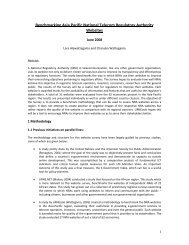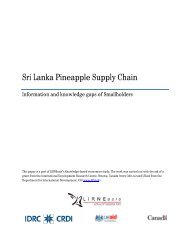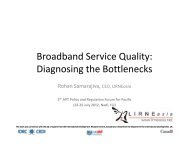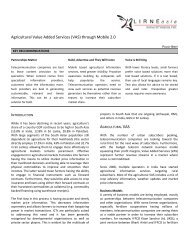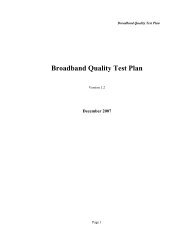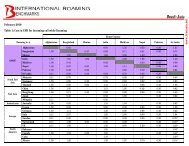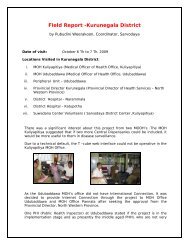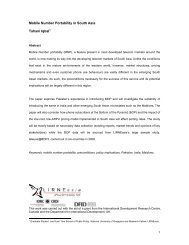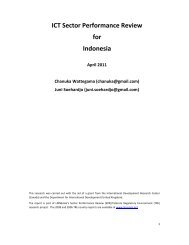Social Influence in Mobile Phone Adoption: Evidence ... - LIRNEasia
Social Influence in Mobile Phone Adoption: Evidence ... - LIRNEasia
Social Influence in Mobile Phone Adoption: Evidence ... - LIRNEasia
- No tags were found...
You also want an ePaper? Increase the reach of your titles
YUMPU automatically turns print PDFs into web optimized ePapers that Google loves.
<strong>Social</strong> <strong>Influence</strong> <strong>in</strong> <strong>Mobile</strong> <strong>Phone</strong> <strong>Adoption</strong>: <strong>Evidence</strong> from theBottom of Pyramid <strong>in</strong> Emerg<strong>in</strong>g Asia 1Harsha de Silva 2 , Dimuthu Ratnadiwakara 3 and Ayesha Za<strong>in</strong>udeen 4AbstractThis paper attempts to quantitatively measure the various <strong>in</strong>fluences on mobilephone adoption at the bottom of the pyramid (BOP) <strong>in</strong> Bangladesh, Pakistan, India,Sri Lanka, Philipp<strong>in</strong>es and Thailand. Based on an exist<strong>in</strong>g theoretical frameworkadoption is modeled by fitt<strong>in</strong>g a logit model to a large six country dataset. The studyf<strong>in</strong>ds evidence for the importance of social <strong>in</strong>fluence <strong>in</strong> mobile adoption <strong>in</strong> twomodes: one that exerts pressure on <strong>in</strong>dividuals to adopt; and another that helpsgenerate benefits via social networks that are tied <strong>in</strong> with economic and bus<strong>in</strong>essnetworks. The paper elaborates on the result<strong>in</strong>g social policy implications for us<strong>in</strong>gmobile telephone services to fight poverty at the BOP <strong>in</strong> these and similar countries.Keywords: mobile phones, bottom of pyramid, adoption, social <strong>in</strong>fluence, networks1This work was carried out with the help of a grant from the International Development ResearchCentre, Ottawa, Canada and the Department for International Development, UK. Additional fund<strong>in</strong>gwas provided by Telenor Research and Development Centre, Cyber Jaya, Malaysia. The authors aregrateful to the valuable comments of Rohan Samarajiva (Chair & CEO, <strong>LIRNEasia</strong>), Christoph Stork(RIA, South Africa). Statistical help from Nishantha Hewavithana (formerly <strong>LIRNEasia</strong>) is alsoacknowledged. Fieldwork was carried out by The Nielsen Company affiliates <strong>in</strong> each country.2Lead economist, <strong>LIRNEasia</strong>, Colombo, Sri Lanka. harsha@lirneasia.net3Former Researcher, <strong>LIRNEasia</strong>, Colombo, Sri Lanka4Research Manager, <strong>LIRNEasia</strong>, Colombo, Sri Lanka.
1. IntroductionThere have been numerous studies on the positive economic impact of phoneadoption. Early studies rang<strong>in</strong>g from Hardy (1980) to the recent Kathuria, Upplaand Mamta (2009) have demonstrated the significant impact of telecom services oneconomic growth and development. From a more microeconomic angle Donner(2006), Jensen (2007), Abraham (2007), Aker (2008), de Silva and Ratnadiwakara(2008) among others have shown how phones reduce <strong>in</strong>formation search costslead<strong>in</strong>g to lower transaction costs. Mov<strong>in</strong>g beyond pure economics, others likeBayes, von Braun and Akhter (1999), Goodman (2005), Frost and Sullivan (2006)and Kwaku and Kweku (2006) have shown how mobile phone adoption leads togreater social cohesion and improved social relationships.The literature generally shows that adoption of (primarily) mobile telephones hav<strong>in</strong>gsignificant benefits not just to the adopter but to the community at large. In thiscontext, the objective of the current paper is to exam<strong>in</strong>e, from a user-perspective, thevarious <strong>in</strong>fluences and the <strong>in</strong>terplay of these <strong>in</strong>fluences on mobile phone adoption bythe poor <strong>in</strong> a selected set of countries <strong>in</strong> the emerg<strong>in</strong>g Asian region. For this purposewe use data from a recent large sample survey by <strong>LIRNEasia</strong> among the poor acrossBangladesh, Pakistan, India, Sri Lanka, the Philipp<strong>in</strong>es and Thailand.2
espondent study across 17 countries <strong>in</strong> Africa. 6 This paper showed <strong>in</strong>come andeducation vastly enhances mobile adoption <strong>in</strong> these countries, but gender, age andmembership <strong>in</strong> social networks have little impact. The last f<strong>in</strong>d<strong>in</strong>g is <strong>in</strong>terest<strong>in</strong>gfrom the theoretical construct of earlier analyzed adoption models <strong>in</strong>clud<strong>in</strong>g VanBiljon and Kotze (2008) where social <strong>in</strong>fluence is an important determ<strong>in</strong><strong>in</strong>g factor,which perhaps Chabassou et al. (2009) implicitly attempted to measure throughmembership <strong>in</strong> various social networks and clubs.The debate on the social pressure and impact on mobile adoption as separate fromeconomic pressures and benefits has been go<strong>in</strong>g on for a long time. But the debate istak<strong>in</strong>g a new twist with adoption <strong>in</strong> develop<strong>in</strong>g country scenarios where mobilephones are seen as a way out of poverty. 7 In this context, f<strong>in</strong>d<strong>in</strong>g social uses (asopposed to bus<strong>in</strong>ess and entrepreneurial uses, as much of the “ICT4D” hype seemsto highlight) of the phone as the ma<strong>in</strong> use of phones among low <strong>in</strong>come earners, deSilva and Za<strong>in</strong>udeen (2007) question why such uses should be considered by some asbe<strong>in</strong>g “frivolous”. Similarly, Donner (2009) criticizes over-emphasis of thedevelopment angle of mobile phone adoption by question<strong>in</strong>g how the value of socialcalls can be ignored when evaluat<strong>in</strong>g the drivers of demand. There are two<strong>in</strong>terrelated issues here. One is the benefits of mobile phone adoption from a socialangle: described <strong>in</strong> Van Biljon and Kotze (2008) as perceived usefulness; as benefitsmeasured by social relations <strong>in</strong> de Silva and Za<strong>in</strong>udeen (2008); or "blurred" socialand bus<strong>in</strong>ess communication implied by Za<strong>in</strong>udeen, Samarajiva and Abeysuriya(2006) as well as Donner (2009). The other issue not explicitly stated is the societalpressure applied by social or social and bus<strong>in</strong>ess networks towards mobile adoption.3. Methodology, Data and Descriptive StatisticsThis paper is based on data from a 2008 representative study conducted by<strong>LIRNEasia</strong> among poor, or “bottom of the pyramid” (BOP) telephone users aged 15-6This study was conducted by RIA. The 17 countries were: Ben<strong>in</strong>, Botswana, Burk<strong>in</strong>a Faso, Cameroon,Cote d’Ivoire, Ethiopia, Ghana, Kenya, Mozambique, Namibia, Nigeria, Rwanda, Senegal, South Africa,Tanzania, Uganda and Zambia.7Nobel Laureate Professor Muhammad Yunus told the author that mobile phones were go<strong>in</strong>g to changethe world as we knew it. "We have not seen the real power of the technology yet" he said, and addedthat a "digital genie" will appear from the "Aladd<strong>in</strong>'s lamp" (mobile phone) to "empower the poor".http://www.youtube.com/watch?v=9O4BvXG_btI5
60 <strong>in</strong> Bangladesh, Pakistan, India, Sri Lanka, Philipp<strong>in</strong>es and Thailand. BOP isdef<strong>in</strong>ed as those belong<strong>in</strong>g to the lowest socioeconomic classification (SEC) 8 groups,D and E. The survey consisted of a quantitative module and a qualitative module.The quantitative module was made up of 9,540 face-to face <strong>in</strong>terviews among thosewho had used a telephone (not necessarily owned) <strong>in</strong> the previous three months. 9 Inaddition, a diary (log sheet) was placed among half the sample <strong>in</strong> which the userswere requested to record their phone usage for a period of one week. 10 An overviewof the sample size and composition is given <strong>in</strong> Table 1.Table 1: Sample Size and CompositionAll BOP Urban BOP Rural BOPMarg<strong>in</strong> of error @95% CL (%)Bangladesh 2,050 1,719 331 3%Pakistan 1,814 899 915 2%India 3,152 773 2,379 2%Sri Lanka 924 320 604 3%Philipp<strong>in</strong>es 800 468 332 4%Thailand 800 400 400 4%Total 9,540 4,579 4,961The qualitative module consisted of 60 protocols <strong>in</strong> the six countries (not equallydistributed) consist<strong>in</strong>g of respondent m<strong>in</strong>i-ethnographies, home visits cum mediamapp<strong>in</strong>g exercises and focused group discussions. 118Def<strong>in</strong>ed by the chief wage earner’s education and occupation (as well as a few other parameters <strong>in</strong>certa<strong>in</strong> countries), but closely correlated to an <strong>in</strong>come level of around USD 2 a day <strong>in</strong> five of the sixcountries studied.9<strong>Phone</strong> use <strong>in</strong> the previous three months <strong>in</strong>cluded mak<strong>in</strong>g or receiv<strong>in</strong>g a telephone call (but not SMS)on any phone whether owned or not.10The diary technique while imperfect is a work-around given almost all BOP owners are prepaidsubscribers without any monthly bills to record call<strong>in</strong>g patterns, while non-owners use phones ofothers (friends, relations, public phones, etc) and similarly have no records of use. A similar techniquewas used <strong>in</strong> a similar survey <strong>in</strong> 2006, learn<strong>in</strong>gs from which have been used to improve the method,s<strong>in</strong>ce.11Further details can be found at http://lirneasia.net/wp-content/uploads/2008/04/qualitativereport.pdf6
4. Statistical Model for <strong>Mobile</strong> <strong>Phone</strong> <strong>Adoption</strong>Logistic regression model for mobile adoptionAs eluded to earlier, Van Biljon and Kotze (2008) expla<strong>in</strong> that adoption and use ofmobile phones will be the result of the complex <strong>in</strong>terplay among a number of factorswith<strong>in</strong> the determ<strong>in</strong><strong>in</strong>g and mediat<strong>in</strong>g categories. In reality, these factors aredifferent for each <strong>in</strong>dividual and cannot be observed. What can be observed iswhether a person has a mobile phone or not; as Chabassou et al. (2009), expla<strong>in</strong>"One <strong>in</strong>dividual might neither be able to afford nor be <strong>in</strong>terested <strong>in</strong> a mobile phonewhile another might just be close to gett<strong>in</strong>g one and still sav<strong>in</strong>g money towards it.For both <strong>in</strong>dividuals it can only be observed that they do not have a mobile phone."The process lead<strong>in</strong>g to the adoption decision is unobservable and the factors used tomodel the adoption decision are referred to as the determ<strong>in</strong><strong>in</strong>g and mediat<strong>in</strong>gfactors. Logit models (as well as probit models) tie the determ<strong>in</strong><strong>in</strong>g and mediat<strong>in</strong>gfactors to the latent variable (i.e. mobile adoption) through contributions to theprobability of the latent variable tak<strong>in</strong>g a value above or below a threshold thatwould lead to the observable outcome: adoption or not. Therefore, the logit modelassigns a probability of adoption of mobile phones based on the various determ<strong>in</strong><strong>in</strong>gand mediat<strong>in</strong>g factors postulated <strong>in</strong> the theoretical model.The general formula of the logit model is:Where Y is mobile adoption (a dichotomous variable tak<strong>in</strong>g the value 1 if therespondent owns a phone and 0 if the respondent does not) and Xi are the factorsthat impact such adoption (also referred to as determ<strong>in</strong><strong>in</strong>g and mediat<strong>in</strong>g factors or<strong>in</strong>fluential factors). βi values are factor sensitivities of each <strong>in</strong>fluential factor, Xi.Influential factors, Xi, can be quantitative or qualitative variables; dummy variablesare used to represent the ‘states’ <strong>in</strong> case of qualitative variables. The <strong>in</strong>fluentialvariables, Xi, used <strong>in</strong> the study as well as their expected signs are given below <strong>in</strong> theTable 2.7
Table 2: Influential variables for the mobile adoption modelVariableExpectedsignRemarks (Van Biljon and Kotze model factor)GenderMale =0, female =1; expect no gender difference(demographic)Age squared 12 - Technology is usually adopted faster by youngerpeople (demographic)Ln(monthly personal<strong>in</strong>come) 13+ Natural log of the monthly personal <strong>in</strong>come; lack of<strong>in</strong>come is key barrier to adoption (socioeconomic).Primary EducationYes = 1, no=0 (demographic)Secondary EducationYes = 1, no=0 (demographic)Tertiary EducationYes = 1, no=0 (demographic)Number of top fivecontacts hav<strong>in</strong>g a mobilephoneEmergency PerceivedBenefits Index (PBI)+ The more people <strong>in</strong> one's close network with phones,greater will be the social (social-economic-bus<strong>in</strong>ess)pressure to adopt (social <strong>in</strong>fluence; social pressure)+ <strong>Phone</strong> enables emergency communication (perceived(safety) usefulness and/or personal)<strong>Social</strong> PBI + <strong>Phone</strong> helps ma<strong>in</strong>ta<strong>in</strong> and improve socialrelationships (perceived (social) usefulness and/orpersonal)Economic PBI + <strong>Phone</strong> br<strong>in</strong>gs economic benefits through lowertransactions costs such as less need to travel toobta<strong>in</strong> bus<strong>in</strong>ess <strong>in</strong>formation (perceived (economic)usefulness and/or personal)Access to a fixed phone - Yes = 1, no=0; mobile phones are substitute for fixedphones at the BOP (facilitat<strong>in</strong>g condition)Walk time to the nearesttown- Proxy for urban and rural <strong>in</strong>dicator; rural adoption islower than urban (demographic factor)Access to electricity + Yes = 1, no=0; electricity as a facilitat<strong>in</strong>g condition formobile adoption(facilitat<strong>in</strong>g condition)Television <strong>in</strong> householdYes = 1, no=0; impact of hav<strong>in</strong>g a television <strong>in</strong>household on mobile adoption (socioeconomic)Radio <strong>in</strong> householdYes = 1, no=0; impact of hav<strong>in</strong>g a radio <strong>in</strong> householdon mobile adoption (socioeconomic)PakistanCountry dummy for PakistanSri LankaCountry dummy for Sri LankaThailandCountry dummy for ThailandBangladeshCountry dummy for BangladeshPhilipp<strong>in</strong>esCountry dummy for Philipp<strong>in</strong>esConstantThe <strong>in</strong>fluential variables are self explanatory and the expected signs are logical.Country dummies capture the unique characteristics <strong>in</strong> each country such asculture, perception, different needs etc. The variable "number of top five contacts12Age 2 has a higher explanatory power compared to Age.13Natural log of monthly <strong>in</strong>come better expla<strong>in</strong>s the impact of monthly <strong>in</strong>come on mobile adoption.8
expected sign for "number of top five contacts hav<strong>in</strong>g a mobile phone" is positive.The th<strong>in</strong>k<strong>in</strong>g is along the same l<strong>in</strong>es of Valentene (1996) who creates a socialnetwork threshold model based on adopter categories to show how external <strong>in</strong>fluenceand op<strong>in</strong>ion leadership channel the diffusion of <strong>in</strong>novation. While Valentene (1996)demonstrated the differences from low network threshold <strong>in</strong>dividuals (those whoadopt before many others <strong>in</strong> their network do) to high threshold <strong>in</strong>dividuals (thosewho adopt after most of their network have adopted), and also the level of<strong>in</strong>novativeness with respect to their 'personal networks' or with respect to the 'socialsystem'; our objective is to ascerta<strong>in</strong> the importance of social pressure or <strong>in</strong>fluence of'personal networks' on adoption of mobile phones.The other <strong>in</strong>novative feature of our work is the attempt to disaggregate and capturethe perceived benefits of mobile adoption <strong>in</strong> terms of emergency, social and economicfactors. Perceived usefulness has been at the base of technology adoption modelss<strong>in</strong>ce the early days of TAM as the extent to which a person believes us<strong>in</strong>g thesystem can enhance his or her job performance, 14 later generalized to mobileadoption by others (Kwon and Chidambaram, 2000; Kleijnen et al., 2004). Follow<strong>in</strong>gthis logic, Van Biljon and Kotze (2008) place perceived usefulness at the centre oftheir model. The model also refers to users’ beliefs on the benefits of mobile phones(<strong>in</strong>clud<strong>in</strong>g, <strong>in</strong>ter alia, image and trust) under personal factors. Once aga<strong>in</strong>, weconsider an alternate approach to the previous models and disaggregate perceivedbenefits of mobile phone adoption <strong>in</strong> to emergency (or safety 15 ), social and economicbus<strong>in</strong>esscategories. Respondents evaluated eleven aspects belong<strong>in</strong>g to the threegroups on a Likert scale of 1 to 5; with 1 <strong>in</strong>dicat<strong>in</strong>g the phone worsen<strong>in</strong>g thatparticular aspect for the respondent, 3 no change and 5 <strong>in</strong>dicat<strong>in</strong>g that it hadimproved. The categorization is given <strong>in</strong> Table 3.14The orig<strong>in</strong>al paper focused on technology adoption <strong>in</strong> organizations15Katz and Aakhus (2001) have shown that safety is the primary motive for women to acquire a mobilephone (<strong>in</strong> Rice & Katz, 2003).10
Table 3: Perceived BenefitsCategoryEmergency<strong>Social</strong>EconomicDisaggregated benefit aspects1. Ability to act <strong>in</strong> an emergency2. Ability to contact others <strong>in</strong> an emergency1. Ability to ma<strong>in</strong>ta<strong>in</strong> relationships with family and friends2. <strong>Social</strong> status/ recognition <strong>in</strong> the community1. Ability to make more money (generally, and not via sale of calls)2. Ability to make more money through the sale of calls3. Ability to f<strong>in</strong>d out about work opportunities4. Ability to access price or market <strong>in</strong>formation5. Ability to save money6. Ability to save on travel cost7. The efficiency of your day to day workThree <strong>in</strong>dices were created to reflect each category of benefits; <strong>Social</strong> PerceivedBenefits Index (SPBI), Emergency PBI (EmPBI) and Economic PBI (EcPBI). SPBIand EmPBI <strong>in</strong>dices reflect the number of benefit aspects (0, 1 or 2) that therespondents perceived to have improved (score of 4 or 5 <strong>in</strong> the scale for each aspect)as a result of us<strong>in</strong>g (whether own or otherwise) a phone; i.e. SPBI would take thevalue two if the respondent perceives benefits have accrued to both aspects <strong>in</strong> thatcategory. EcPBI has four levels. The first level is when the respondent sees eitherno aspects or only one aspect has improved; second is when the respondent perceivestwo or three economic aspects have improved; third if four or five aspects haveimproved and f<strong>in</strong>ally the fourth level is when the respondent perceives six or allseven aspects have improved.5. F<strong>in</strong>d<strong>in</strong>gs and DiscussionTable 4 provides an easy-to-<strong>in</strong>terpret breakdown of the sample show<strong>in</strong>g thecharacteristics of mobile phone adopters versus non-adopters (who are usersnevertheless, us<strong>in</strong>g other's phones). 16 The Chi-Square value given <strong>in</strong> the table<strong>in</strong>dicates where there are significant associations between the two variables. 1716Rice and Katz (2003) present a similar table where they dichotomize almost all variables <strong>in</strong> order tomake it easier to <strong>in</strong>terpret the otherwise complex data.17A significant Chi-Square value <strong>in</strong>dicates the existence of a relationship between the concernedvariable and mobile adoption.11
Table 4: <strong>Mobile</strong> adopters versus non-adoptersOverallNGender (Chi-Square=401.30)***MaleFemaleNAge (Chi-Square=33.32)***Less than 35 yrsMore than 35 yrsNMonthly Personal Income (Chi-Square=363.16)***Less than the median [USD 26.25]More than the median [USD 26.25]NEducation (Chi-Square=291.0)***PrimarySecondaryTertiaryNNumber of top five contacts with mobiles (Chi-Square=801.52)***012345NEmergency Perceived Benefit Index (PBI) (Chi-Square=20.49)***012N<strong>Social</strong> PBI (Chi-Square=176.15)***012NEconomic PBI (Chi-Square=197.76)***1234NAccess to fixed phone (Chi-Square=23.09)***YesNoN<strong>Mobile</strong> adopter(% of sample)45.94,38263.936.14,38265.334.74,38137.762.34,27735.152.012.94,1230.96.412.215.314.750.54,3812.59.987.64,3184.030.965.14,23010.127.630.831.54,2567.992.14,382Non adopter(% of sample)54.15,15843.456.65,15859.640.65,15860.939.14,90151.143.75.24,2452.711.923.524.013.124.85,1553.012.684.34,8006.246.251.34,72018.133.123.425.44,69310.889.25,15812
Walk time to nearest town (Chi-Square=125.76)***Less than the median [20 m<strong>in</strong>utes]More than the median [20 m<strong>in</strong>utes]NAccess to electricity (Chi-Square=569.14)***YesNoNTelevision <strong>in</strong> household (Chi-Square=569.14)***YesNoNRadio <strong>in</strong> household (Chi-Square284.11)YesNoNNote: *** Chi-Square is significant at 95%<strong>Mobile</strong> adopter(% of sample)57.142.94,46991.88.24,38280.919.14,38148.351.74,382Non adopter(% of sample)46.653.45,07177.322.75,15957.142.95,15831.468.65,158The table shows that at a high level, mobile phone adaptors (or owners) at the BOP<strong>in</strong> the study countries are more likely to be younger males, with higher relative<strong>in</strong>come, with ma<strong>in</strong>ly a secondary education with most of their closest contactsalready hav<strong>in</strong>g mobile phones of their own. 18 They perceive that their phones haveimproved their social and economic aspects of their lives and helped theircapabilities to communicate <strong>in</strong> emergencies. It is found that they also live somewhatcloser to a town with relatively better access to electricity and with a television set<strong>in</strong> the household. The profile for non-adopters, <strong>in</strong> contrast to adopters, is ma<strong>in</strong>lyyounger females <strong>in</strong> a relatively lower <strong>in</strong>come bracket and only a primary educationliv<strong>in</strong>g somewhat further away from town. We also f<strong>in</strong>d that less of their closestcontacts have their own phones. In terms of perceived benefits we f<strong>in</strong>d non-adoptersnot very different from adopters <strong>in</strong> terms of plac<strong>in</strong>g value on benefits from mobilephones. While emergency benefits seem to be the same there is a slight drop <strong>in</strong>perceived social and economic benefits. This is perhaps due to the fact that theyanyway have access to phones even though they do not own their own.18The mean is USD 47.75 per month. The adoption profile is the same even dichotomized at USD 50per month: adopters, less than USD50, 48.6%; more than USD 50, 51.6%; non-adopters, less than USD50, 73.3%; more than USD 50, 26.5%.13
We now consider the results of the logit model to assign probabilities of adoption ofmobile phones to correspond to, as much as possible, the mediat<strong>in</strong>g and determ<strong>in</strong><strong>in</strong>gfactors postulated <strong>in</strong> the theoretical model <strong>in</strong> Van Biljon and Kotze (2008). Expectedsigns for the variables along with brief remarks for same were provided <strong>in</strong> Table 2.The logit model showed a good fit with an R-square (Nagelkerke R-square) value of0.34. The signs of the coefficients of the variables are as expected except <strong>in</strong> the caseof gender where we pre-supposed no gender difference. 19 Coefficients of variables <strong>in</strong>a logit model can have either positive or negative values; a positive value <strong>in</strong>dicatesthat that particular variable has a positive impact on adoption and vice versa. Oddsratios allow for <strong>in</strong>terpretation of the size of the impact as coefficients cannot bedirectly <strong>in</strong>terpreted due to their non-l<strong>in</strong>ear relationship with the dependent variable.The odds of success are def<strong>in</strong>ed as the ratio of the probability of success (mobilephone adoption) divided by the probability of failure (non-adoption); i.e., odds<strong>in</strong>crease as the probability of success <strong>in</strong>creases and vice versa. Here an odds ratio ofX would mean that the odds of mobile adoption are X to 1. Therefore, an odds ratioof greater than 1 implies a positive impact on mobile adoption and less than 1<strong>in</strong>dicates a negative impact for each unit <strong>in</strong>crease <strong>in</strong> the particular variable. Higherodds ratios of greater than 1 imply greater positive impact and an odds ratio closerto zero imply greater negative impact. Odds ratios for variables <strong>in</strong> logit models canbe calculated by tak<strong>in</strong>g the exponent of each the coefficient. 20 Table 5 conta<strong>in</strong>s theresults.19While theoretically that may be the case, gender neutral, many studies have found that males aremore likely to adopt mobile phones over females (Katz, 2003, Chabassou, 2008).2014
Table 5: Logit Model ResultsVariableCoefficientOddsRatioP-valueAge 2 -0.03 0.97 0.03Gender -0.43 0.65 0.00Ln (monthly personal <strong>in</strong>come) 0.48 1.61 0.00Primary Education 0.34 1.41 0.00Secondary Education 0.80 2.23 0.00Tertiary Education 1.40 4.06 0.00Number of top five contacts hav<strong>in</strong>g a mobile0.32 1.37 0.00phoneEmergency Perceived Benefits Index (PBI) 0.20 1.22 0.07<strong>Social</strong> PBI 0.16 1.18 0.01Economic PBI 0.10 1.10 0.00Access to a fixed l<strong>in</strong>e connection <strong>in</strong> household -0.63 0.54 0.00Walk time to the nearest town 0.00 1.00 0.01Access to electricity 0.38 1.47 0.00Television <strong>in</strong> household 0.90 2.46 0.00Radio <strong>in</strong> household 0.29 1.33 0.00Bangladesh -0.05 0.65 0.96Pakistan -0.42 0.00 0.66Sri Lanka -0.82 0.00 0.44Philipp<strong>in</strong>es -0.23 0.12 0.80Thailand 1.27 0.00 3.58Constant -4.21 0.02 0.00Start<strong>in</strong>g with the demographics of the model, it is observed that age 21 is likely tohave negative impact on mobile adoption; younger people are more likely than olderpeople to purchase a mobile phone. The gender variable has a significant impact onadoption; be<strong>in</strong>g a woman decreases the probability of own<strong>in</strong>g a mobile phone by afair amount; odds of female mobile adoption is 35 percent less than odds of malemobile adoption. As expected, <strong>in</strong>come <strong>in</strong>creases the probability of adoption, with thenatural log of monthly personal <strong>in</strong>come hav<strong>in</strong>g an odds ratio of 1.61. The resultsalso show that assumptions about education can be accepted with the odds ratio ofmobile adoption <strong>in</strong>creas<strong>in</strong>g significantly with more years of education.21Age-squared gives more explanatory power to the model compared with the Age. As Tegegne (1999)and Chabossou et al. (2009) po<strong>in</strong>t out differences of the impact of the age <strong>in</strong> mobile adoption can bebetter modeled by us<strong>in</strong>g Age-squared <strong>in</strong>stead of Age.15
<strong>Social</strong> pressure or <strong>in</strong>fluence on mobile adoption was found to be a very importantfactor <strong>in</strong> <strong>in</strong>creas<strong>in</strong>g the probability of adoption, with an odds ratio of 1.37. Thismeans that the likelihood of a respondent's adoption of a mobile phone <strong>in</strong>creaseswith each additional member (at the marg<strong>in</strong>) among the closest five members of hisor her personal network adopt<strong>in</strong>g a mobile phone. More specifically, hold<strong>in</strong>g other<strong>in</strong>fluential variables fixed, the odds of adopt<strong>in</strong>g a mobile phone <strong>in</strong>creases by 37percent for each additional member <strong>in</strong> the network hav<strong>in</strong>g adopted. It was alsofound that the likelihood of adoption <strong>in</strong>creases quite dramatically, with an odds ratioof 4.86, when the number of persons own<strong>in</strong>g a mobile among the closest five contacts<strong>in</strong>creases from none to five. Table 6 depicts the relationship between the top fivecontacts own<strong>in</strong>g a mobile phone and the respondent's mobile adoption status.Table 6: <strong>Influence</strong>s of personal network on mobile adoptionNo. of members of top fivecontacts that own a mobilephone<strong>Mobile</strong> adopter(% of sample)Non adopter(% of sample)0 22.0 78.01 31.5 68.52 30.6 69.43 35.1 64.94 48.9 51.15 63.3 36.7Another significant f<strong>in</strong>d<strong>in</strong>g is that, as per Valentene (1996) the poor <strong>in</strong> emerg<strong>in</strong>gAsia seem to belong to high to very high threshold categories where adoption istak<strong>in</strong>g place after most of the others <strong>in</strong> the personal network have adopted. It mayalso be the case <strong>in</strong> terms of the social system, but data for outside SEC D and E arenot available for such a comparison.Consider<strong>in</strong>g the contribution of the perceived benefit <strong>in</strong>dices towards the probabilityof mobile adoption, all three <strong>in</strong>dices are significant; as expected each exerts apositive impact on adoption <strong>in</strong>dicat<strong>in</strong>g that higher likelihood of mobile adoption bythe people who perceive higher level of benefits from phone access <strong>in</strong> terms ofemergency, social and economic criteria. 22 The odds ratios are 1.22, 1.18 and 1.10;mean<strong>in</strong>g that hold<strong>in</strong>g other <strong>in</strong>fluential variables fixed, odds of adopt<strong>in</strong>g a mobile22Emergency perceived benefit <strong>in</strong>dex is significant at 90% while social and economic perceived benefits<strong>in</strong>dices are significant at 95%.16
phone <strong>in</strong>creases by 22 percent, 18 percent and 10 percent, for every one unit <strong>in</strong>crease<strong>in</strong> the perceived emergency, social and economic benefit <strong>in</strong>dex respectively.Perceived usefulness has been considered an important <strong>in</strong>fluence <strong>in</strong> mobile adoptionfrom the earliest technology adoption theories and models. The desegregation ofperceived benefits <strong>in</strong> to the above three categories and measur<strong>in</strong>g their impact onthe probability of adoption of mobile phones among the BOP <strong>in</strong> this manner nowadds flavor to the discussion on how best to leverage on this aspect to furtherenhance adoption.Tables 7 through 9 provide category-wise disaggregated data on the respondent’sadoption status by the number of perceived benefits accrued from a mobile phone.Table 7: Emergency Perceived Benefits <strong>in</strong>dex and mobile adoptionNo of perceived emergency<strong>Mobile</strong> adopterNon adopterbenefits accrued due to use of(% of sample)(% of sample)mobile phone0 42.1 57.91 41.4 58.62 48.3 51.7Table 8: <strong>Social</strong> Perceived Benefits <strong>in</strong>dex and mobile adoptionNo of perceived socialbenefits accrued due to use ofmobile phone<strong>Mobile</strong> adopter(% of sample)Non adopter(% of sample)0 36.8 63.21 39.4 60.12 53.2 46.8Table 9: Economic Perceived Benefits <strong>in</strong>dex and mobile adoptionNo of perceived economicbenefits accrued due to use ofmobile phone<strong>Mobile</strong> adopter(% of sample)Non adopter(% of sample)1 31.6 68.42 43.5 56.53 53.7 46.34 54.1 45.9These results <strong>in</strong>dicate that adoption is l<strong>in</strong>ked to the level of perception of benefits (orusefulness as <strong>in</strong> the theoretical adoption literature) accrued due to use of mobilephones particularly with social and economic factors; the higher the perceived17
enefits, the higher the adoption. While the adopter percentage is higher than nonadopterpercentage at the highest level of perceived benefit (highest <strong>in</strong>dex number)for social and economic benefit categories it is not so for the perceived emergencybenefit category. Perhaps the importance of emergency benefits (ability to contactothers <strong>in</strong> an emergency) is subsumed <strong>in</strong> the "blurred" social-economic network andcannot be easily isolated.6. Conclud<strong>in</strong>g ThoughtsThis paper attempted to determ<strong>in</strong>e and measure the various <strong>in</strong>fluences on mobilephone adoption at the BOP <strong>in</strong> Bangladesh, Pakistan, India, Sri Lanka, Philipp<strong>in</strong>esand Thailand. Based on the Van Biljon and Kotze (2008) theoretical frameworkadoption was modeled by fitt<strong>in</strong>g a logit model to a six country dataset. In addition toseveral other important variables, evidence for the importance of social <strong>in</strong>fluence <strong>in</strong>mobile adoption was found <strong>in</strong> two modes: one that exerts pressure on <strong>in</strong>dividuals toadopt; and another that helps generate benefits via social networks that are tied <strong>in</strong>with economic and bus<strong>in</strong>ess networks.<strong>Mobile</strong> phones, now <strong>in</strong>creas<strong>in</strong>gly affordable and widespread <strong>in</strong> the develop<strong>in</strong>g world,have significant potential to extend social policy <strong>in</strong>itiatives to the most rural and/orexcluded groups <strong>in</strong> society, and thus have a direct impact on poverty and <strong>in</strong>equality.<strong>Mobile</strong>s provide a direct channel to provide services (for example telemedic<strong>in</strong>e,election <strong>in</strong>formation, hazard warn<strong>in</strong>gs, etc) directly to BOP-type markets which canfurther social policy objectives.This paper has shown that network effects play a key role <strong>in</strong> mobile adoption; thosewith a larger share of their closest contacts who already have a mobile are morelikely to adopt; this means that people tend to get connected <strong>in</strong> groups. From asocial policy perspective, policies that encourage network market<strong>in</strong>g (by operators;that is, “friends and family” type packages and promotions, or offer<strong>in</strong>g benefits tousers who br<strong>in</strong>g others onto the network) will therefore help to further social policyobjectives. While from a competition policy perspective, network market<strong>in</strong>g is notseen as desirable (mak<strong>in</strong>g customers “sticky”), one could argue that such market<strong>in</strong>gonly reflects consumer behavior.18
Further research is needed to ascerta<strong>in</strong> whether or not such network effects alsoplay a role <strong>in</strong> the adoption of <strong>in</strong>dividual services, however it is likely that the same“groups” that come onto a network together will encourage service adoption with<strong>in</strong>their networks too.The study however has a several limitations; particularly it only models adoptionand not usage and does not attempt to l<strong>in</strong>k the social pressure with the three benefitcategories to assess, for <strong>in</strong>stance op<strong>in</strong>ion leadership and the Katz (1957) two-stepflow hypothesis of adoption <strong>in</strong>fluence. Further research could also help fill thesegaps. Notwithstand<strong>in</strong>g these drawbacks, this study has been able to isolate whatseem to be some very powerful <strong>in</strong>fluences of mobile adoption that will be useful <strong>in</strong>understand<strong>in</strong>g and <strong>in</strong>fluenc<strong>in</strong>g the adoption process of mobile 2.0 services amongthis population.19
ReferencesAbraham, R. (2007), <strong>Mobile</strong> <strong>Phone</strong>s and Economic Development: <strong>Evidence</strong> From theFish<strong>in</strong>g Industry <strong>in</strong> India, Indian School of Bus<strong>in</strong>ess, Hyderabad, India. InformationTechnologies and International Development, Volume 4, Issue 1Aker, J. (2008), Does Digital Divide or Provide? The Impact of <strong>Mobile</strong> <strong>Phone</strong>s onGra<strong>in</strong> Markets <strong>in</strong> Niger, Center for Global Development, Work<strong>in</strong>g Paper No. 154Bayes, A., von Braun, J. & Akhter, R. (1999), Village Pay <strong>Phone</strong>s and PovertyReduction: Insights from a Grameen Bank <strong>in</strong>itiative <strong>in</strong> Bangladesh, ZEF DiscussionPapers on Development Policy No. 8, Centre for Development Research, Bonn.Chabossou, A., Stork, C., Stork, M. & Zahonogo, Z. (2009), <strong>Mobile</strong> Telephony Accessand Usage <strong>in</strong> Africa, <strong>in</strong> ICTD 2009 Proceed<strong>in</strong>gs of the Third InternationalConference on Information and Communication Technologies and Development,Carnegie Mellon Qatar, Doha, Qatar, April 17-19, 2009.Chen, W. & Sutanto, P. (2007), <strong>Social</strong> Understand<strong>in</strong>g of <strong>Mobile</strong> CommunicationTechnology, The Seventh International Conference on Electronic Bus<strong>in</strong>ess (ICEB),Taipei, pp. 300-303Chen, W. & Wong, S.F. (2003), An Empirical Exam<strong>in</strong>ation of the Use of <strong>Mobile</strong>Technology, Third International Conference of Electronic Bus<strong>in</strong>ess (ICEB),S<strong>in</strong>gapore, pp. 500-502.Davis F.D. (1989), Perceived Usefulness, Perceived Ease of Use and User Acceptanceof Information Technology, MIS Quarterly 13, pp. 319–340Davis, F. D., Bagozzi, R. P. & Warshaw, P. R. (1989), User Acceptance of ComputerTechnology: A Comparison of Two Theoretical Models, Management Science, 35,982-1003.de Silva, H. & Za<strong>in</strong>udeen, A. (2007), Poverty Reduction through Telecom Access atthe Bottom of the Pyramid. Centre for Poverty Analysis Annual Symposium onPoverty Research <strong>in</strong> Sri Lanka, Colombo, December 6 -7, 2006de Silva, H. & Ratnadiwakara, D. (2008), Us<strong>in</strong>g ICT to Reduce Transaction Costs <strong>in</strong>Agriculture through Better Communication: A Case-study from Sri Lanka.http://lirneasia.net/wp-content/uploads/2008/11/transactioncosts.pdfde Silva, H. & Za<strong>in</strong>udeen, A. (2008), Teleuse at the Bottom of the Pyramid: BeyondUniversal Access, Telektronikk, Vol. 104. No. 2, pp. 25-38.de Vos, H., Hofte, H. & de Poot, H. (2004), IM [@work]: adoption of <strong>in</strong>stantmessag<strong>in</strong>g <strong>in</strong> a knowledge worker organization, Proceed<strong>in</strong>gs of the 37th HawaiiInternational Conference on System Sciences, January 5-8, 200420
Donner, J. (2006), The Use of <strong>Mobile</strong> <strong>Phone</strong>s by Microentrepreneurs <strong>in</strong> Kigali,Rwanda: Changes to <strong>Social</strong> and Bus<strong>in</strong>ess Networks. Information Technologies andInternational Development 3 (2), pp. 3-19.Donner, J. (2009), Blurr<strong>in</strong>g Livelihoods and Lives: The <strong>Social</strong> Uses of <strong>Mobile</strong> <strong>Phone</strong>sand Socioeconomic Development. Innovations: Technology, Governance,Globalization, 4(1), pp. 91-101Fishbe<strong>in</strong>, M. & Ajzen, I, (1975), Belief, Attitude, Intention, and Behavior: AnIntroduction to Theory and Research, Read<strong>in</strong>g, MA, Addison-Wesley.Frost & Sullivan (2006). <strong>Social</strong> impact of mobile telephony <strong>in</strong> Lat<strong>in</strong> America.Goldste<strong>in</strong> N.J., (2009), Harness<strong>in</strong>g <strong>Social</strong> Pressure, Harvard Bus<strong>in</strong>ess Review,February, 2009, pp. 25Goodman, J. (2005), L<strong>in</strong>k<strong>in</strong>g <strong>Mobile</strong> <strong>Phone</strong> Ownership and Use to <strong>Social</strong> Capital <strong>in</strong>Rural South Africa and Tanzania, Vodafone Policy Paper Series, Number 2Hardy, A.P. (1980), The Role of the Telephone <strong>in</strong> Economic Development,Telecommunications Policy, 4(4), pp. 278–286.Jensen, R. (2007), The Digital Provide: IT, Market Performance and Welfare <strong>in</strong> theSouth Indian Fisheries Sector, Quarterly Journal of Economics, 122 (3), 879-924.Kathuria, R, Uppal M & Mamta, (2009), "An Economietric Analysis of the Impact of<strong>Mobile</strong>" <strong>in</strong> The Policy Paper Series, No. 9, January 2009, Indian Council forResearch on International Economic Relations (ICRIER)Katz, E., (1957), "The Two-Step Flow of Communication: An Up-to-date Report on aHypothesis" <strong>in</strong> Public Op<strong>in</strong>ion Quarterly, 21, pp. 61-78Kiljander, H, (2004), "Evolution and Usability of <strong>Mobile</strong> <strong>Phone</strong> Interaction Styles",Department of Computer Science and Eng<strong>in</strong>eer<strong>in</strong>g, Hels<strong>in</strong>ki University ofTechnology, Hels<strong>in</strong>ki.Kwaku Kyem, P. A., Kweku & LeMaire, P, (2006), Transform<strong>in</strong>g Recent Ga<strong>in</strong>s <strong>in</strong> theDigital Divide <strong>in</strong>to Digital Opportunities: Africa and the Boom <strong>in</strong> <strong>Mobile</strong> <strong>Phone</strong>,Central Connecticut State University, USA, Electronic Journal of InformationSystems <strong>in</strong> Develop<strong>in</strong>g Countries, Volume 28.Kwon, H.S. & Chidambaram, L. (2000), "A Test of the Technology AcceptanceModel", Proceed<strong>in</strong>gs of the 33rd Hawaii International Conference on SystemSciencesMalhotra, Y. & Galletta, D. F. (1999), "Extend<strong>in</strong>g the Technology Acceptance Modelto Account for <strong>Social</strong> <strong>Influence</strong>: Theoretical Bases and Empirical Validation";Proceed<strong>in</strong>gs of the 32nd Annual Hawaii International Conference on SystemSciences.21
Pederson P. E. (2005), <strong>Adoption</strong> of mobile Internet services: an exploratory study ofmobile commerce early adopters. Journal of Organizational Comput<strong>in</strong>g andElectronic Commerce. v15, pp. 203-222Pedersen P. E. & L<strong>in</strong>g R., (2002), <strong>Mobile</strong> End-User Service <strong>Adoption</strong> Studies: ASelective Review, Scand<strong>in</strong>avian Journal of Information Systems, 14Pedersen, P.E., Nysveen H. & Thobjørnsen H. (2003), <strong>Adoption</strong> of <strong>Mobile</strong> Services.Model Development and Cross-Service Study.http://ikt.hia.no/perep/cross_service_jams.pdfRice, R. E., & Katz, J. E., (2003), Compar<strong>in</strong>g Internet and <strong>Mobile</strong> <strong>Phone</strong> Usage:Digital Divides of Usage, <strong>Adoption</strong>, and Dropouts; Telecommunications Policy, 27,pp. 597-623Rogers, E. M. (2003), "Diffusion of Innovations"; (5th Edition), The Free Press, NewYorkSegrest, S.L., Domke-Damonte, D.J., Miles A.K. & Anthony, W.P., (1998), Follow<strong>in</strong>gthe Crowd: <strong>Social</strong> <strong>Influence</strong> and Technology Usage, Journal of OrganizationalChange Management (11:5), pp. 425-445Silverstone, R. & Haddon, L. (1996), "Design and the Domestication of Informationand Communication Technologies: Technical Change and Everyday Life";Communication by Design: The Politics of Information and CommunicationTechnologies, R. Mansell & R Silverstone (eds.), Oxford University, Oxford, 44-74.Velentene. T. W., (1996), "<strong>Social</strong> Network Thresholds <strong>in</strong> the Diffusions ofInnovations", Population Communication Services, Center for CommunicationPrograms, School of Hygiene and Public Health, The Johns Hopk<strong>in</strong>s University,Baltimore, MD.Van Biljon, J., and Kotzé, P. (2008). Cultural Factors <strong>in</strong> a <strong>Mobile</strong> <strong>Phone</strong> <strong>Adoption</strong>and Usage Model. Journal of Universal Computer Science, vol. 14, no. 16 (2008),p.2650-2679Venkatesh, V., Morris, M. G., Davis, G. B. & Davis, F. D. (2003), "User Acceptance ofInformation Technology: Toward a Unified View"; MIS Quarterly 27, 3, 425-478.Za<strong>in</strong>udeen, A., Samarajiva, R. & Abeysuriya, A. (2006) Telecom Use on a Shoestr<strong>in</strong>g:Strategic Use of Telecom Services by the F<strong>in</strong>ancially Constra<strong>in</strong>ed <strong>in</strong> South Asia.WDR Dialogue Theme 3rd cycle Discussion Paper WDR0604, Version 2.0. Availableat http://www.lirneasia.net/wpcontent/uploads/2006/02/Za<strong>in</strong>udeen%20Samarajiva%20Abeysuriya%202006%20teleuse%20strategies.pdf22




